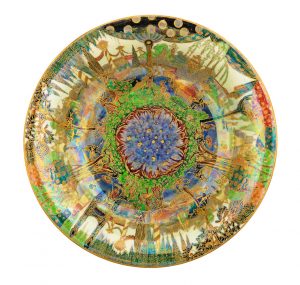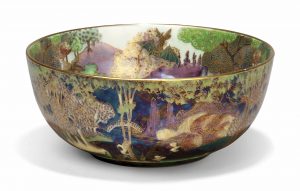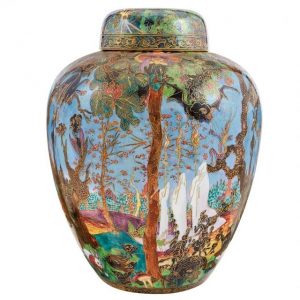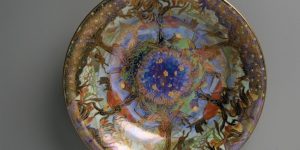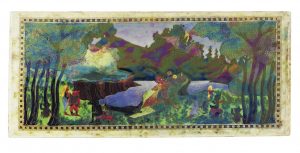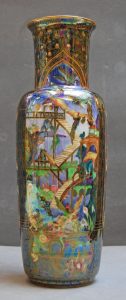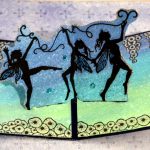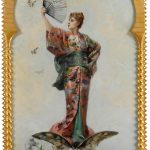Daisy Makig-Jones is my favourite ceramic artists. She worked for Wedgwood from around 1909 until the 1930’s when her fairy patterns became unfashionable. During the 1920’s the patterns were really popular especially in America. The 1930’s started to see clean fashions with more geometrical designs.
The thing I love about her work is the detail. You can look at them and find more fairies every time you look. Basically, I think she is a fairy lover’s paradise.
Daisy Makeig-Jones for Wedgwood: a very fine Fairyland Lustre Lily Tray, circa 1925 The circular shallow bowl decorated with the ‘Fairy Gondola’ pattern, the elaborate Italianate scene incorporating numerous fairy folk including ‘Fairy with a Large hat’, the underside mottled in green lustre with a gilt ‘Flight of Birds’ border, 33cm diam, Portland Vase mark
Sold for £ 3,125 inc. premium at Bonhams in 2018
A WEDGWOOD FAIRYLAND LUSTRE ‘WOODLAND BRIDGE I (EXTERIOR), PICNIC BY A RIVER (INTERIOR)’ IMPERIAL BOWL DESIGNED BY DAISY MAKEIG-JONES, CIRCA 1930 With gilt-heightened decoration, under glaze printed label ‘WEDGWOOD ENGLAND’ and in black marked ‘Z 4968 D’ 3 ½ in. (9 cm.) high; 8 in. (20 cm.) diameter
Sold for GBP 2,375 at Christies in 2018
Wedgwood Fairyland Lustre Ware Ghostly Wood Malfrey Pot and Cover Decorated by Daisy Makeig-Jones, shape no. 2312, pattern no. Z4968, 1920s Incised shape number and painted pattern mark, Portland Vase symbol and WEDGWOOD ENGLAND stamp mark in black. Height 12 3/4 inches.
Cover professionally restored; body of vase in good condition overall Most often known for classic design and “Wedgwood blue” in Jasperware, Wedgwood departed from its subdued colors with the creation of a completely innovative design aesthetic known as Fairyland lustre wares. To combat difficult financial times in the wake of the First World War, Wedgwood targeted the luxury and elite market with fanciful scenes and bright colors. Designed by Susannah Margaretta “Daisy” Makeig-Jones from 1916 until the 1930s, Fairyland lustre ware took inspiration from a variety of book illustrations, including the “Color Fairy Books” edited by Andrew Lang, and other literary tales. The present example was inspired by “The Legends of Croquemitaine” by Gustav Doré among other sources. Often referred to as the “Ghostly Wood” pattern, the bold underglaze enamels and gilding on this malfrey pot depict woods, ghosts, fairies, and goblins from the “Land of Illusion” tale in Doré’s book. With no space left undecorated, fantastic characters and scenes include the white rabbit from Lewis Carroll’s “Alice in Wonderland.” A similar example is in the collection of the Victoria and Albert Museum in London.
Sold for $13,750 (includes buyer’s premium) at Doyle New York in 2017
Bowl ‘Jumping faun’, ‘Fairyland lustre’ series, porcelain, Josiah Wedgwood & Sons/ Daisy Makeig-Jones, England, 1920-1930 Made in England, United Kingdom, Europe, C1920. Bowl ‘Jumping faun’, ‘Fairyland lustre’ series, porcelain, Josiah Wedgwood & Sons/ Daisy Makeig-Jones, England, 1920-1930 A shallow bone china bowl with brightly coloured interior mostly in blue, green and purple lustre and gold. The well applied with an irregularly shaped patch of mottled blue glaze with stylised gold printed flowers. The wide rim painted with a continuous scene of an island with several trees radiating from the centre, their foliage forming the pattern on the outside edge. Numerous fairies and fauns frolic on the island and in and around the trees. There are also Oriental junks sailing on a lake amongst pagodas and bridges around the island. The outside of the bowl is glazed with green mottled lustre and features gold birds in flight.
Reference: Museum of Applied Art and Sciences
A WEDGWOOD ‘FAIRYLAND LUSTRE’ RECTANGULAR PLAQUE 1920s designed by Daisy Makeig-Jones, decorated with a version of ‘Picnic by a River’, with a blue sky, blue river, green grass and black and green trees, within a checkered border, together with its original ebonized wood frame, gold printed Portland Vase and WEDGWOOD ENGLAND and painted pattern number Z5156. 2 pieces height 4 3/4 in.; width 10 3/4 in. 12 cm; 27.3 cm
Sold for 8,750 USD at Sothebys in 2018
Fairyland lustre vase, tall and slim, narrows at shoulders, slightly flaring at neck. The decoration is based on two Japanese myths. Kuan Yin, a Buddhist deity, poured water of creation over the earth – it fell in a series of bubbles and within each was a baby. The other concerning a Goddess who aided villagers terrorized by a dragon fond of eating children’s flesh. Bubbles, fairies, city and figure riding on a boat/bird are depicted.
Reference: © Victoria and Albert Museum

